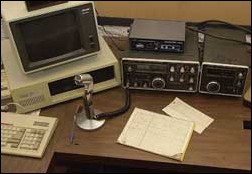When Disaster Strikes…

Image: When Disaster Strikes…:The Emergency Operations Center in Shasta Hall has modern technology capabilities to aid the campus in a disaster situation. The room has never been used for emergency reasons. -Photo by David Olson/State Hornet:
November 5, 2003
In the event of a toxic chemical spill, a flood or other majorcatastrophe Sacramento State would be run from the EmergencyOperations Center, a windowless room in Shasta Hall.
“If the disaster is big enough, then the EOC would beopened,” said Ken Barnett, director of the department ofpublic safety. “Otherwise we run things at a locallevel.”
The EOC in Shasta Hall has modern computers, Internet and phoneconnections as well as a HAM radio that could link Sac State withthe outside world in the event of a disaster. The room has neverbeen used for disaster purposes.
Since the Northridge earthquake in 1993, Sac State has prepareditself for the event of a major disaster, anticipating its affecton students. During that earthquake, Cal State-Northridge washeavily damaged as the epicenter was just miles from thecampus.
Wildfires also closed four CSU campuses last week. They reopenedwith minimal damage.
“Our biggest concerns are of a train derailing andspilling its load along the tracks,” said Vice President ofStudent Affairs Shirley Uplinger. “The other is the leveebursting and the campus flooding.”
In the event of a disaster university staff would spring intoaction to quickly mobilize students and get them to safety.
“The University Union would be the best place to be in theevent of a disaster,” said Don Tucker, associate director ofoperations for the University Union. “We’d move peopleup to the second and third floors in the event of a flood.We’d keep people there until the water subsided or helparrived.”
All staff members in the Union, who are equipped with cellularphones, would be in contact with Facilities Management personneland public safety officials.
“In the event of a chemical spill we would just seal upthe building and shut off the ventilation system,” Tuckersaid. “That would be the safest thing for thestudents.”
The Union also has medical supplies and staff in the StudentHealth Connection, which would be used in the event of acampus-wide emergency.
During a campus-wide emergency, every building has an emergencycoordinator who is responsible overseeing procedures in theirarea.
“Often times it’s better to stay put rather thanevacuate,” Uplinger said. “In a flood, if someone triedto drive out of here, they would drown.”
Uplinger also urged students to have a plan for what to do athome in the event of a disaster.
“In the event of something catastrophic, students mightnot be able to get home right away,” Uplinger said.”It’s important to let your roommates or family knowwhat to do until you get there.”
If the university were shut down, campus e-mail systems andCASPER would be shut down. Only basic services would beavailable.
“No student would be at risk academically if we shutdown,” said Ric Brown, vice president for academic affairs.”Arrangements would be made to make up the lost time butduring the closure, no professors are allowed to holdclasses.”
David Levy from the CSUS Foundation said Sac State would lose anaverage $20,000 a day in dining service revenue as well as $15,000to $20,000 in sales from the bookstore if the school were closeddue to disaster.
Sac State was closed during the 1986 floods as a precautionarymeasure.













































































































































